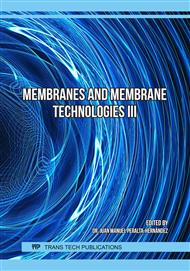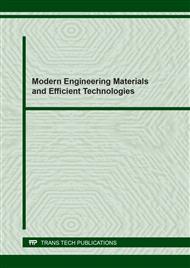[1]
B. Metz, O. Davidson, H. Coninck, M. Loos and L. Meyer, IPCC Special Report on Carbon dioxide Capture and Storage. Prepared by Working Group III of the International Panel on Climate Change, Cambridge University Press, Cambridge (2005).
Google Scholar
[2]
A. E. Creamer and B. Gao, Carbon Dioxide Capture: An Effective Way to Combat Global Warming Springer Briefs in Green Chemistry for Sustainability DOI 10.1007/978-3-319-17010-7_2 (2015)1-9.
Google Scholar
[3]
C. M. White, B. R. Strazisar, E. J. Granite, J. S. Hoffman and H. W. Pennline, Separation and capture of CO2 from large stationary sources and sequestration in geological formations coal beds and deep saline aquifers, J. Air & Waste Management Association 53 (2003) 645-715.
DOI: 10.1080/10473289.2003.10466206
Google Scholar
[4]
D. Bera, P. Bandyopadhyay, S. Ghosh, S. Banerjee and V. Padmanabhan, Highly gas permeable aromatic polyamides containing adamantane substituted triphenylamine, J. Memb. Sci. 474 (2015) 20-31.
DOI: 10.1016/j.memsci.2014.09.032
Google Scholar
[5]
T. Zhu, X. Yang, Y. Zhang, Y. Zheng, X. He and J. Luo, Random and block copolymer membranes based on flexible etheric-aliphatic soft segments designed for CO2/CH4 separation, J. Natur. Gas Sci. and Eng. 54 (2018) 92-101.
DOI: 10.1016/j.jngse.2018.04.003
Google Scholar
[6]
S. Duan, T. Kai and S. Kazama, Development and fabrication of PAMAM-based composite membrane module with a gutter layer of Chitosan/PAA polymer double network for CO2 separation, IOP Conference Series: Materials Science and Engineering, 2019,.
DOI: 10.1088/1757-899x/479/1/012106
Google Scholar
[7]
B. Sasikumar, S. Bisht, G. Arthanareeswaran, A. F. Ismail and M. H. D. Othman, Performance of polysulfone hollow fiber membranes encompassing ZIF-8, SiO2/ZIF-8, and amine-modified SiO2/ZIF-8 nanofillers for CO2/CH4 and CO2/N2 gas separation, Sep. Purif. Tech. 264 (2021) 118471.
DOI: 10.1016/j.seppur.2021.118471
Google Scholar
[8]
P. Natarajan, B. Sasikumar, S. Elakkiya, G. Arthanareeswaran, A. F. Ismail, W. Youravong, E. Yuliwati, Pillared cloisite 15A as an enhancement filler in polysulfone mixed matrix membranes for CO2/N2 and O2/N2 gas separation, J. Nat. Gas. Sci. Eng. 86 (2021) 103720.
DOI: 10.1016/j.jngse.2020.103720
Google Scholar
[9]
T. Zhu, X. Yang, X. He, Y. Zheng and J. Luo, Aromatic polyamides and copolyamides containing fluorene group: Synthesis, thermal stability, and gas transport properties High Performance, Polymers 30 (2017) 821-832.
DOI: 10.1177/0954008317732121
Google Scholar
[10]
A. S. Kovvali, H. Chen and K. K. Sirkar, Dendrimer membranes: A CO2-selective molecular gate, J. Am. Chem. Soc. 122 (2000) 7594–7595.
DOI: 10.1021/ja0013071
Google Scholar
[11]
A. S. Kovvali and K. K. Sirkar, Dendrimer Liquid Membranes: CO2 Separation from Gas Mixtures, Ind. & Eng. Chem. Res. 40 (2001) 2502–2511.
DOI: 10.1021/ie0010520
Google Scholar
[12]
H. Xie, J. K. Johnson and R. J. Perry, A computational study of the heats of reaction of substituted monoethanolamine with CO2 , J. Phys. Chem. A 115 (2011) 342-350.
Google Scholar
[13]
D. A. Tomalia, H. Baker, J. Dewald, M. Hall, G. Kallos, S. Martin, J. Roeck, J. Ryder and P. Smith, Dendritic macromolecules: synthesis of starburst dendrimers, Macromolecules 19 (1986) 2466-2468.
DOI: 10.1021/ma00163a029
Google Scholar
[14]
S. Duan, A.Ito and A.Ohkawa, Separation of propylene/propane mixture by a supported liquid membrane containing triethylene glycol and a silver salt, J. Memb. Sci. 251 (2003) 53–60.
DOI: 10.1016/s0376-7388(02)00601-4
Google Scholar
[15]
S. Duan, T. Kouketsu, S. Kazama and K. Yamada, Development of PAMAM dendrimer composite membrane for CO2 separation, J. Memb. Sci. 283 (2006) 2–6.
DOI: 10.1016/j.memsci.2006.06.026
Google Scholar
[16]
F. Moghadam, E. Kamio, T. Yoshioka and H. Matsuyama, New approach for the fabrication of double-network ion-gel membranes with high CO2/N2 separation performance based on facilitated transport, J. Memb. Sci. 530 (2017) 166-175.
DOI: 10.1016/j.memsci.2017.02.032
Google Scholar
[17]
L. M. Robeson, The upper bound revisited, J. Memb. Sci. 320 (2008) 390–400.
Google Scholar
[18]
J. Wang, Y. Zang, G. Yin, T. Aoki, H. Urita, K. Taguwa, L. Liu, T. Namikoshi, M. Teraguchi, T. Kaneko, L. Ma and H. Jia, Facile synthesis of five 2D surface modifiers by highly selective photocyclic aromatization and efficient enhancement of oxygen permselectivities of three polymer membranes by surface modification using a small amount of the 2D surface modifiers, Polymer 55 (2014) 1384-1396.
DOI: 10.1016/j.polymer.2013.11.046
Google Scholar
[19]
M. X. Tang, C. T. Redemann and F. C. Szoka, In vitro gene delivery by degraded polyamidoamine dendrimers. Bioconj. Chem. 7(6) (1996) 703-714.
DOI: 10.1021/bc9600630
Google Scholar




